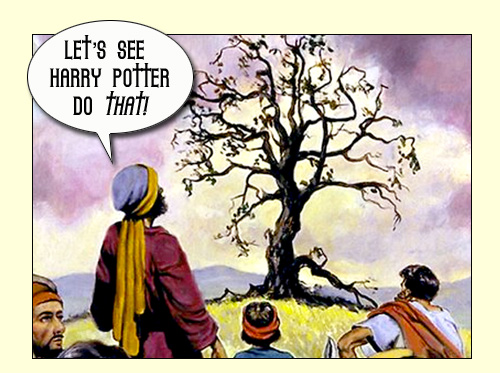Thu 15 Sep 2011
Jesus and the Fig Tree
Posted by anaglyph under Atheism, Food & Drink, Plants, Religion, Skeptical Thinking, The Baffling Bible
[51] Comments
Tetherd Cow Ahead Presents: The Baffling Bible
Episode #5: Jesus and the Fig Tree

When I was a kid in Sunday School, I learned lots about the life of Jesus. I knew the stories of the Sermon on the Mount, the casting out of demons into swine, the miracle of the loaves & fishes, the overturning of the moneylenders’ tables in the tabernacle and many other colourful yarns that have turned out to have about as much relevance to my adult life as they did to my ten-year-old self.
One baffling tale that doesn’t usually get much of an airing when the life of Our Lord is being recounted, though, is the story of Jesus and the Fig Tree. It certainly didn’t make it into my Bible class back in the day – I think it’s just possible that’s because a ten-year-old might’ve empathized with it all too well.
To set the the scene: Jesus has returned from his 40 days and nights in the desert where he has had a lengthy hobnob with God, and is traipsing across the countryside accumulating crowds ((We should take mentions of ‘crowds’ in the Bible with a grain of salt. That part of the world was not especially densely populated at that time, and I suspect that if you got a toothless man and his wife and their goat to come out and look at you, that probably counted as a ‘crowd’. Especially in the eyes of someone spinning a yarn to beat up some PR, as Matt and Mark unquestionably are.)) of the faithful and assembling the cabal of chaps who would end up as his apostles. This is the Jesus of Matthew and Mark. This is the Jesus we all know and love from the comic books; he has just appeared to his followers (and Matthew & Mark’s readers) in dazzling white raiment which of course proves he is not just some guy like all the other common-garden-variety Messiahs who were touring the land at the time. In addition, he takes every opportunity to voice noble (if mostly obvious and occasionally curious) moral advice, and he performs miracles. Lots of them. ((I feel I have to point out that, in the light of the way we are familiar with ‘healings’ & clairvoyance and visions of the Virgin and other contemporary ‘miracles’, you don’t have to try too hard to come up with fairly reasonable non-supernatural explanations for all Jesus’ marvellous conjurations. And given nearly 20 centuries of undoubted ’embroidery’, well…))
The Story of the Fig Tree is one such miracle. We’ll take up the tale with Jesus waking up one morning after having spent the night in the countryside outside Jerusalem (somewhere around here I figure). Over to Matthew to relate the tale in his compelling literary style:
Now in the morning as he returned into the city, he hungered.
And when he saw a fig tree in the way, he came to it, and found nothing thereon, but leaves only, and said unto it, Let no fruit grow on thee henceforward for ever. And presently the fig tree withered away.
And when the disciples saw it, they marvelled, saying, How soon is the fig tree withered away!
~(Matthew 21:19)
In other words, because Jesus was hungry and there were no figs, he threw a tantrum and did the supernatural equivalent of punching his fist through the wall: he put a curse on the tree. Kapow! Take THAT you stupid tree! I’ll teach you not to have figs out of season!
Now religious scholars are quick to put forward all kinds of explanations for this decidedly tetchy Saviour behaviour. It’s certainly not fashionable these days to have Jesus to appear to petulantly invoke his super powers out of spite, so most modern Christian scholars interpret the story of Jesus and the Fig Tree as some kind of metaphorical statement about the condition and the predicted eventual fate of the Jewish nation.
But I want you to pause and reflect on that for a moment. None of Jesus’ other miracles get the ‘allegory’ explanation. If Jesus does a really cool thing – like healing a blind man, say, or walking across a lake – that’s not a metaphor. That’s a myrrh-soaked, gold-plated, frankinsence-doused, cross-my-heart-and-hope-to-die-and-never-be-resurrected MIRACLE! But when Our Lord chucks a tanty and fries a fig tree, well then, that must be symbolic…
That’s all well and good, and I might even buy it except for one thing: both Matthew and Mark independently make the effort to point out that Jesus was hungry. This tiny detail makes nonsense of the fall-of-the-Jewish-nation explanation. How does that high-falutin’ symbolism have anything to do with Jesus not getting breakfast? Plus, it just gives the whole story a ring of truth – I mean, we’ve all been there, right?
No, Faithful Acowlytes, I believe that the most reasonable hypothesis for this story is that Jesus just got out of bed on the wrong side and took his grumpiness out on the first thing he saw (and I offer this as scientific endorsement of my assertion). Luckily it was just a tree – his dad had something of a tendency to take his pique out on entire cities.
Or maybe, just maybe, the Westboro Baptist Church has had it right all along, only their bibles have a small typographical error…





Me and my goat are coming right over to look at you.
I like it when people read the footnotes :)
Not having ever gone to Sunday school (or been xtian (or religious)) or anything in that direction, that always was one of the (other) parts of their bible that confused me.
I’m trying to think of something witty to add here, but it’s all just too fucking weird.
You want to talk about the Bible and confusion? The Bible makes Dianetics look like Newton’s Principia.
So that’s what happened to my fig tree! And I was blaming the neighbor spraying it with herbicide because it was in his view. It’s a pretty tough tree, JC has zapped it twice now and it keeps coming back.
First post here, by the way. I’ve been enjoying the blog for six months or so.
Well, an official Welcome to The Cow, Trebuchet.
As far as your fig tree is concerned, have you considered that your neighbour is trying to make some kind of metaphorical comment on the Israel/Palestine situation? As far as the Bible is concerned, it would be a fair defence in court.
I couldn’t give a fig.
That’s what the tree said, and Jesus put a curse on it. I’d watch out if I were you.
AHA! This explains everything!
Hmmm. That seems a bit too scientific for JC. I think his tanty was magical.
Oooh. A magical tantrum. Well, I guess it runs in the family.
It’s a good thing that he didn’t meet some old lady who happened to not have any bread.
Which also brings up the question – if he could turn water into wine, and divide the loaves and fishes to feed gobs of people (or the 2 people and the goat, but remember goats eat a lot), he couldn’t just make the tree produce figs? I mean, he had to curse it? Really? This is the savior? Really. Hmmm, no wonder I wandered away…
Theoretically he could have made the fig tree bear a couple of baskets of croissants, a fresh-brewed coffee and a nice pot of fig jam. That’s the thing about miracles – they’re miraculous!
Didn’t He cause the juniper bush to bring forth juniper berries?
I think the juniper bush story is just a Christian fairytale. Oh wait, what am I saying… the WHOLE BIBLE is a Christian fairytale!
Anyway, it’s more made-up than the stuff that Matthew and Mark made up. In any case – juniper berries for breakfast? Are you kidding?
I think it was Brian
PseudoMatthew set down his pen and looked wearily out the eastward-facing window, noticing the impending dawn. He’d written non-stop through the night. Not since the days spent writing his magnum opus, Peter: At the Lord’s Right Hand, had he been so completely taken by the Muse. He recalled fondly those days — how he would enjoy respite walking in the garden with his dog, Judas, and how a luscious fig, from the tree his wife had planted on their wedding day, would revive him sufficiently to write for another hour or two before settling into a blissful morning’s slumber. Massaging his aching fingers, he stared at the long-dead tree, placidly silhouetted against the lightening sky.
“Goddamned fucking thing!”, he muttered under his breath, causing Judas to raise himself shakily and move to the far corner of the room. He bit grudgingly into the hunk of unleavened crust his weathered and worn-out wife had grumpily left for him some eight full hours ago.
Then, his eyes still fixed upon the barren tree, he picked up his pen and resumed writing.
MATTHEW: Remember when Jesus walked across the lake?
MARK: For Christ’s sake, will you stop hovering.
MATTHEW: And I’d like to recognize Mark and Barnabas, both of the Apostles’ Auxiliary …
MATTHEW: So how goes the gospel-writing?
MARK: Slowww.
MATTHEW: Yeah, I hear ya.
MATTHEW: Hey Mark – Jehoshaphat the baker says he’ll give us a year’s supply of luncheon rolls if we mention his bakery somewhere in loaves and fishes story. Whaddya say?
MATTHEW: Did you read the gospel that John wrote?
MARK: Yeah, man. What’s up with that?
Hahaha!
MATTHEW: Hey Mark: used pen nibs make great roach clips.
MARK: You know you’re not getting paid for any of this, right?
MATTHEW: Whatcha got there?
MARK: Shhhhhhh … Figs.
MATTHEW: This is the fifth Messiah I’ve hung out with.
MARK: Second for me … unless you include John the Baptist …
MATTHEW: Luke’s writing a sequel to his gospel.
MARK: The fucker …
MATTHEW: Right now, I’m in tax-collections; but really I’m a writer.
MATTHEW: … And then I’m gonna have him rise from the dead.
MARK: Ooh, I like that!
Hahahaha!
MATTHEW: What’s the past tense of ‘smite’?
MARK: Er…
MATTHEW: Seems like everyone I know is writing a gospel.
MARK: Well, when in Rome …
MATTHEW: I’ve got the Lord feeding a few thousand with loaves and fishes.
MARK: I’ve got Him hittin’ a few million with SPAM.
MATTHEW: The Lord doesn’t really LOOK Jewish, does He?
MARK: I was thinkin’ the same dang’d thing.
Here I am and he’s writing about divine tantrums on trees…
I’d watch out if I were you.
[img]http://joeyshole.files.wordpress.com/2011/09/moses01.jpg[/img]
Hahahahha!
MATTHEW: I heard they’re getting two new writers on this thing. We’ll probably have to share the credit.
MARK: Happens every time the studio gets involved.
MATTHEW: Fred’s writing a gospel …
MARK: Tsk.
[img]http://joeyshole.files.wordpress.com/2011/09/derwents.jpg[/img]
MATTHEW:The Lord said he’d come again.
MARK: Again?
[img]http://joeyshole.files.wordpress.com/2011/09/sermon.jpg[/img]
[img]http://joeyshole.files.wordpress.com/2011/09/already.jpg[/img]
it’s true dat, i am no longer funny.